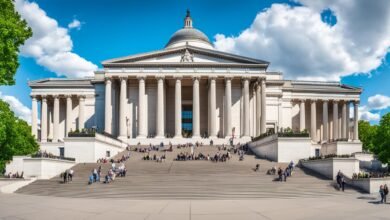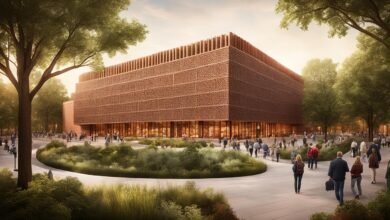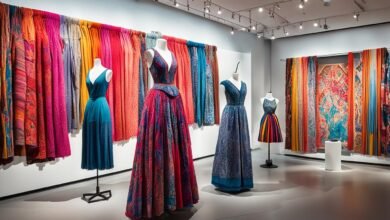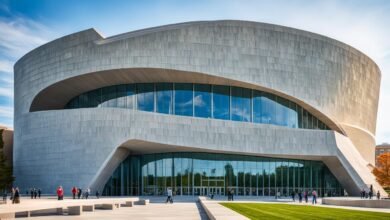Table of Contents
Did you know the National Museum of Natural History at the Smithsonian in Washington DC has over 125 million artifacts? This huge collection places it among the top museums globally. It lets us explore geology, biology, anthropology, and more.
Are you into ancient fossils or shiny gems? Maybe you love learning about animals? This famous place has it all for anyone curious.
People from everywhere should see the Natural History Museum in Washington DC. It’s full of history and amazing exhibits. Let’s go see the best parts, learn cool stuff, and enjoy unique adventures.
Highlights of the Museum’s Collection
The Smithsonian National Museum of Natural History boasts a wide array of exhibits. You can explore precious gems, dinosaur specimens, and displays on animal life. These offer a deep look into the diversity of nature.
Gems and Minerals
Step into the world of geology at the Hall of Geology, Gems, and Minerals. See the famous 46-karat Hope Diamond and be amazed. You will also find the Star of Asia Sapphire and the Gachala Emerald, showcasing Earth’s geological beauty.
Dinosaurs and Paleobiology
The Hall of Dinosaurs and Paleobiology has over 46 complete dinosaur specimens. See the Tyrannosaurus Rex and Triceratops up close. This exhibit lets you dive into the prehistoric world, learning about dinosaur life, behavior, and their ancient environments.
Mammals and Oceanic Exhibits
This part of the museum takes you through various ecosystems. See life-size models of whales, dolphins, and more marine animals. It teaches about marine life’s roles and the variety of mammals, from African elephants to snow leopards. This section highlights the importance of every living being and nature’s balance.
Exploring the museum, you step into a world of natural marvels. From the sparkle of gems to the grandeur of ancient dinosaurs, the museum is a journey through Earth’s history. It invites awe and offers insights into the natural world.
| Highlights: | Exhibits |
|---|---|
| Famous Jewel: | Hope Diamond |
| Gems: | Star of Asia Sapphire, Gachala Emerald |
| Dinosaurs: | Over 46 complete dinosaur specimens |
| Mammals: | African elephant, snow leopard, and more |
| Oceanic Exhibits: | Whales, dolphins, and marine creatures |
The History of the Museum
The National Museum of Natural History has a long story that started with the Smithsonian Institution’s creation. It first found its home in the Smithsonian Castle. Later, in 1881, it moved to the Arts and Industries Building.
The museum’s growing collection needed more space. So, a new, larger building was built and opened its doors in 1910. This Neoclassical-style structure, known for its distinctive green dome, stands out on the National Mall to this day.
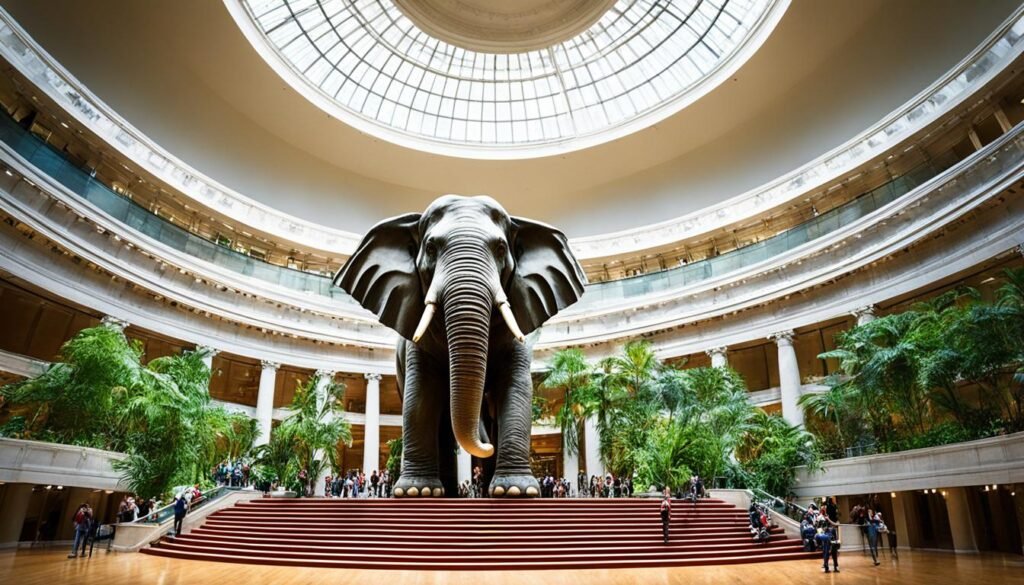
The museum welcomes visitors every day, except Christmas. It’s open from 10am to 5:30pm. During summer, it stays open longer.
Inside the Museum
When you walk into the National Museum of Natural History, Henry greets you. He’s a 14-foot-tall African elephant that is hard to miss. He marks the start of an incredible journey inside the museum.
The museum’s rotunda, which is newly renovated, is stunning. The famous compass on the floor grabs your attention right away. Moving past the rotunda, you see exhibits that share the beauty of nature.
The David H. Koch Hall of Human Origins offers a deep dive into who we are. You’ll find interactive displays and exhibits that make you think.
In the Hall of Dinosaurs and Paleobiology, you’re taken back in time. You can see ancient creatures and their huge skeletons. It’s like looking into a prehistoric world.
The museum also explores the cultural history of various regions. You’ll learn about civilizations and their effects on the environment. It shows how human societies changed the world.
“The National Museum of Natural History is filled with knowledge and wonder. It has a wide range of exhibits. This makes it a special place to learn about nature’s beauty and our planet’s history.”
Walking through the museum, the exhibitions will hold your interest. There are ancient artifacts and experiences that feel real. Every part of the museum gives you something new to discover.
| Exhibition | Description |
|---|---|
| David H. Koch Hall of Human Origins | Explore human evolution and unique traits with interactive displays and exhibits. |
| Hall of Dinosaurs and Paleobiology | Step back in time to see ancient creatures in striking displays. |
| Galleries on Cultural History | Learn about civilizations’ development and their environmental impact through artifacts. |
Q?rius and Other Attractions
The National Museum of Natural History offers exciting attractions beyond its exhibits. Q?rius is a unique education center for teens and preteens. They can dive into hands-on scientific adventures here. The Johnson IMAX Theater shows nature films in 3D, making viewers feel part of the action. This museum also organizes sleepovers for kids 8 to 12 years old. Nearby, other Smithsonian museums on the National Mall await exploration. These include the National Museum of American History, National Gallery of Art, and the National Air and Space Museum.
| Attraction | Description |
|---|---|
| Q?rius | An education center for hands-on scientific exploration. |
| Johnson IMAX Theater | An immersive experience with 3D nature films. |
| Sleepovers | Overnight adventures for children aged 8 to 12. |
| National Museum of American History | Explore the cultural heritage of the United States. |
| National Gallery of Art | Admire Western art spanning centuries. |
| National Air and Space Museum | Discover the history of flight and space exploration. |
Q?rius: Where Science Comes to Life
Q?rius is a special part of the National Museum of Natural History. It offers teens and preteens interactive experiences. They can get hands-on with real specimens and the latest tech. Activities include looking at fossils, doing experiments, and solving science mysteries. Q?rius helps satisfy their curiosity about the natural world in fun ways.
Johnson IMAX Theater: An Immersive Movie Experience
The Johnson IMAX Theater shows nature films in amazing 3D. Its advanced technology makes the natural world leap off the screen. Viewers can see incredible wildlife and learn about Earth’s ecosystems in a unique way. This theater offers a special look at our planet’s beauty.
Sleepovers: A Night at the Museum
For 8 to 12-year-olds, the museum has memorable sleepover events. Kids can tour the museum at night, play educational games, and hear bedtime stories near favorite exhibits. These sleepovers offer a magical museum experience. Kids make lasting memories while learning about nature in an entertaining environment.
Explore Other Smithsonian Museums
Next to the National Museum of Natural History, there are more Smithsonian museums to visit. The National Museum of American History displays the country’s history through various exhibits and artifacts. At the National Gallery of Art, visitors can view masterpieces by famous artists. The National Air and Space Museum takes you on an exciting history of aviation and space exploration. Here, iconic aircraft and spacecraft are on show.
Getting to the Museum
The National Museum of Natural History is in Washington DC. It’s a must-see spot that’s easy to get to. You can drive or use public transport to arrive comfortably.
By Car:
Driving to the museum? Parking nearby is hard to find. A great choice is using the Old Town Trolley. It lets you get around the city without parking stress.
By Public Transportation:
Using public transport is smart and green. The Orange and Blue lines stop at the Smithsonian and Federal Triangle stations. The Green and Yellow lines stop at Archive-Penn Quarter station. These stations are close to the museum, making your trip easier.
Best Time to Visit:
To avoid crowds, visit on a weekday, ideally Monday to Wednesday. Weekends and holiday seasons are usually very busy. Visiting at the right time makes your experience better.
Ready to discover the Natural History Museum Washington DC? Set off on a journey filled with exciting finds. You’ll see fossils, gems, and more. It’s perfect for people of all ages.
Know Before You Go
Planning your trip to the National Museum of Natural History in Washington DC? There are some tips you’ll need to know. These will help you enjoy your visit fully.
- National Museum of Natural History hours: The museum welcomes visitors every day, except Christmas. This lets you discover its wonders all year round.
- Operating hours: Doors open at 10am and close at 5:30pm. Summer months offer extended hours. This gives you more time to explore.
- Entrances: You can enter through two doors. One is on Constitution Avenue, and the other is near the National Mall. Both are convenient.
- Security checkpoints: For everyone’s safety, there are security checks, much like at airports. Following the museum’s rules during these checks is important.
You can bring strollers, cameras, and bottled water to enhance your visit. But, things like camera stands, weapons, and aerosol sprays are not allowed on-site.
Getting to know these points helps you plan well. This way, you can make the most of your visit to the National Museum of Natural History.
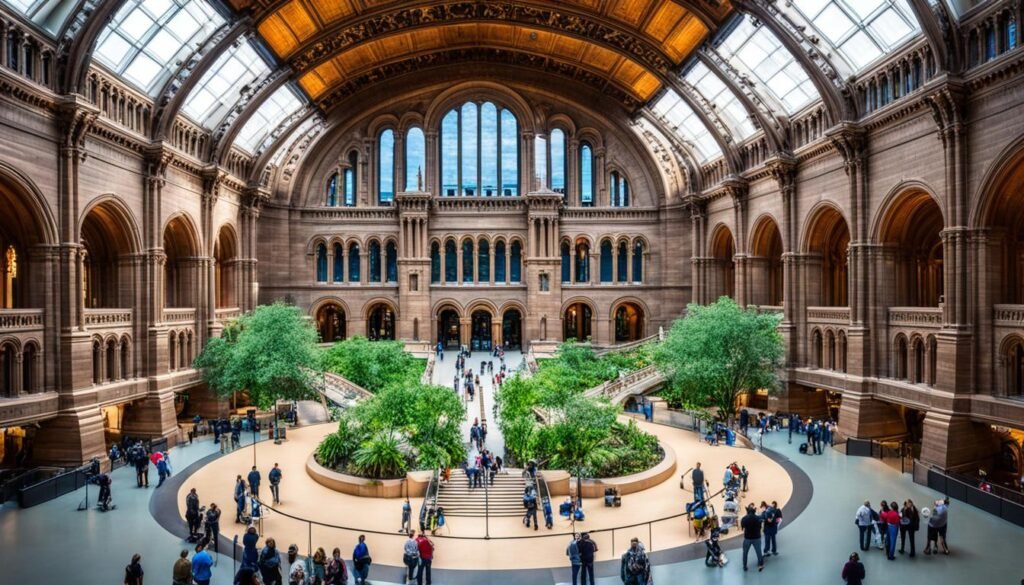
Nearby Attractions
The National Museum of Natural History has other great spots close by. Enhance your visit by exploring these nearby cultural gems:
National Museum of American History
Explore America’s rich heritage at the National Museum of American History. See the original Star Spangled Banner and Dorothy’s Ruby Slippers. Learn about America’s past with interactive exhibits and engaging stories.
National Gallery of Art
Dive into the world of art at the National Gallery of Art. It has art from the Middle Ages to today. See works by da Vinci, van Gogh, and Monet. Be amazed by stunning sculptures and paintings from different cultures.
National Air and Space Museum
Experience the adventure of flight and space at the National Air and Space Museum. See the Wright Brothers Flyer and a moon rock. Discover human exploration beyond Earth with exciting exhibits and technology.
Plan Your Visit to Smithsonian’s Natural History Museum
Are you thinking about visiting the National Museum of Natural History in Washington DC? First, check the museum’s website for up-to-date info. You’ll find details on National Museum of Natural History hours, special shows, and visitor rules. Weekdays, especially from Monday through Wednesday, are less busy.
Planning a Saturday visit or coming during the busy season from mid-March to late-July? Expect more people then. Still, the National Museum of Natural History has lots of exhibits and learning experiences. Your visit will be unforgettable.
Good news: entering the museum is free. It’s perfect for family trips or solo adventures. Interested in old fossils, rare gems, or our planet’s ecosystems? The National Museum of Natural History has something for everyone.
